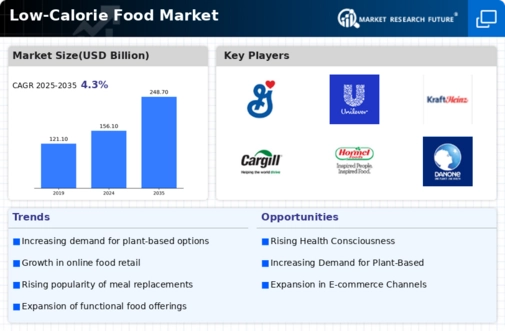Rising Health Awareness
The increasing awareness regarding health and wellness among consumers appears to be a primary driver for the Low-Calorie Food Market. As individuals become more informed about the implications of their dietary choices, there is a noticeable shift towards low-calorie options. Reports indicate that a significant portion of the population is actively seeking to reduce caloric intake to manage weight and prevent lifestyle-related diseases. This trend is particularly evident among millennials and Generation Z, who prioritize health in their purchasing decisions. Consequently, manufacturers are responding by innovating and expanding their low-calorie product lines, which further fuels market growth. The Low-Calorie Food Market is thus positioned to benefit from this heightened focus on health, as consumers increasingly opt for products that align with their wellness goals.
Growing Demand for Convenience Foods
The growing demand for convenience foods is another significant driver for the Low-Calorie Food Market. As lifestyles become increasingly hectic, consumers are seeking quick and easy meal solutions that do not compromise their health goals. Low-calorie ready-to-eat meals, snacks, and beverages are gaining traction as they offer the convenience of preparation without the guilt of excessive caloric intake. Market data suggests that the segment of ready-to-eat low-calorie meals is expanding rapidly, with a notable increase in sales over recent years. This trend indicates that consumers are willing to invest in products that align with their busy lifestyles while supporting their dietary preferences. Consequently, the Low-Calorie Food Market is likely to continue evolving to meet this demand for convenience, thereby enhancing its market presence.
Influence of Social Media and Marketing
The influence of social media and targeted marketing strategies is becoming increasingly apparent in the Low-Calorie Food Market. Social media platforms serve as powerful tools for brands to engage with health-conscious consumers, promoting low-calorie products through influencers and targeted advertisements. This digital engagement not only raises awareness but also fosters a community around healthy eating habits. As consumers share their experiences and preferences online, brands are encouraged to adapt their offerings to meet these evolving demands. The visibility of low-calorie options on social media is likely to drive consumer interest and purchasing behavior, contributing to the overall growth of the market. The Low-Calorie Food Market, therefore, stands to benefit from this dynamic interplay between social media influence and consumer engagement.
Regulatory Support for Healthier Food Options
Regulatory support for healthier food options is emerging as a vital driver for the Low-Calorie Food Market. Governments and health organizations are increasingly advocating for dietary guidelines that promote lower caloric intake and healthier eating habits. Initiatives aimed at reducing obesity rates and improving public health are leading to policies that encourage the production and consumption of low-calorie foods. For instance, some regions have implemented taxes on sugary beverages while providing incentives for manufacturers to develop healthier alternatives. This regulatory environment is likely to create a favorable landscape for the Low-Calorie Food Market, as it aligns with public health objectives and consumer demand for healthier choices. As such, the market may experience growth driven by these supportive policies and initiatives.
Technological Advancements in Food Production
Technological advancements in food production and processing are likely to play a crucial role in shaping the Low-Calorie Food Market. Innovations such as advanced food preservation techniques, improved flavor enhancement methods, and the development of low-calorie sweeteners are enabling manufacturers to create products that are not only lower in calories but also appealing in taste and texture. For instance, the use of biotechnology in food production has led to the creation of healthier ingredients that can replace traditional high-calorie components. This evolution in food technology is expected to attract a broader consumer base, as the availability of diverse low-calorie options increases. As a result, the Low-Calorie Food Market may experience accelerated growth driven by these technological innovations, which enhance product quality and consumer satisfaction.


















Leave a Comment